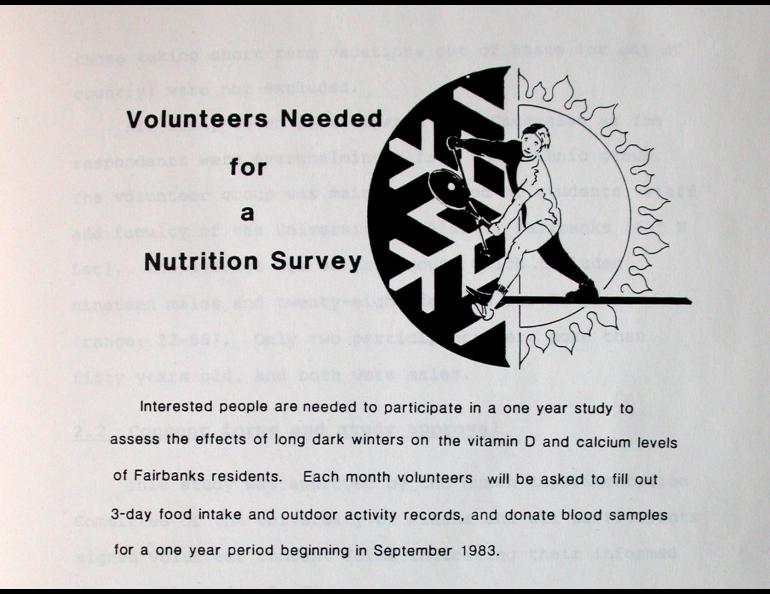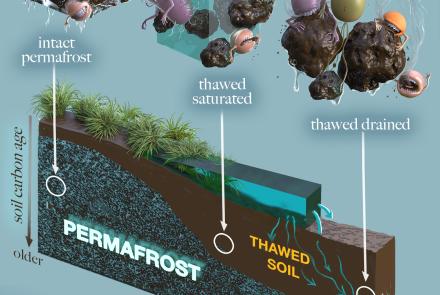

Alaska’s vitamin D production slows with the season
Interested people are needed to participate in a one-year study to assess the effects of long dark winters on the vitamin D and calcium levels of Fairbanks residents.
So began a recruitment poster Meredith Tallas created more than 25 years ago. Now living in California, Tallas was in 1983 a University of Alaska Fairbanks student who wanted to study how levels of a vitamin related to sun exposure fluctuated in people living so far from the equator.
“The most obvious vitamin to study in Alaska is vitamin D, because of the low light in winter,” Tallas said over the phone from her office in Berkeley.
Forty-seven people responded to Tallas’ 1983 request, and her master’s project was underway. By looking at the bloodwork of those Fairbanks residents every month and analyzing their diets, she charted their levels of vitamin D, which our skin magically produces after exposure to a certain amount of sunshine. We also get vitamin D from foods, such as vitamin-D enriched milk and margarine, and fish (salmon are a good source). Vitamin D is important for prevention of bone diseases, diabetes and other maladies.
If you live at latitude farther north than about 42 degrees (Boston, Detroit, or Eugene, Oregon), the sun is too low on the horizon from November through February for your skin to produce vitamin D, according to the National Institutes of Health. Tallas also saw another potential Alaska limitation on the natural pathway to vitamin D production.
“Most outdoor activity requires covering all but the face and hands approximately seven months of the year,” she wrote in her thesis. “During the summer months residents keep much of their bodies clothed because of the persistent and annoying mosquitoes and biting flies and because of this, an Alaskan summer suntan becomes one of the face and hands.”
But even overbundled Alaskans show signs of enhanced vitamin D production from the sun. Tallas found the highest levels of vitamin D in the Fairbanks volunteers’ blood in July, and the lowest levels in March. Tallas attributed the July high occurring about a month after summer solstice to the time needed for the body’s processing of sunlight and the conversion to vitamin D.
In Tallas’ study, volunteers showed low levels of vitamin D in winter months, but most got sufficient doses of vitamin D from sources other than the sun. Tallas also found that males had an average of 16 percent more vitamin D in their blood throughout the study, which she attributed in part to men being outside more.
In charting an average for people’s time outside (you can’t convert sunlight to vitamin D through windows), she found December was the low point of sunlight exposure, when sun struck the skin of her volunteers for less than 20 minutes per day. People spent an average of more than two hours exposed to Alaska sunlight in June and July. They seemed to hunker down in October, when time outside in the sun dropped to about half an hour. That was after almost two hours of daily sun exposure in September.
Vitamin D levels in the volunteers’ blood dropped in August, September, October, November, December, January, February, and March, but Tallas saw an occasional leap in midwinter.
“When someone had gone to Hawaii, we could see, very exactly, a significant spike in their vitamin D levels,” Tallas said. “The only surprise was how it came a month or two after.”
In her thesis, Tallas wrote that a midwinter trip to somewhere close to the equator would be a good thing for boosting Alaskans’ vitamin D levels.
“Presuming that an individual’s lowest circulating vitamin D level in found in March or April, such trips could potentially have a very significant effect in improving late winter vitamin D status,” she wrote in her thesis.
An easy alternative for Alaskans not traveling southward during the winter is eating foods rich in vitamin D or taking vitamin D supplements, Tallas said.





